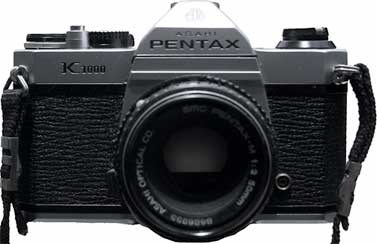
Approx. dates of manufacture: 1976 to 1997
Lens Mount: Pentax K
Approx. original price: $157.99
Approx. street value: moderate
Asahi Optical was a japanese firm that made eyeglass lenses, binoculars, and other optical equipment before and during World War II. After that they added cameras to the list. Their camera line is (at least in the US) called Pentax. In the US, Honeywell imported it for many years, so cameras from the 50s, 60s and early 70s are usually branded Honeywell Pentax, whereas later ones are Asahi Pentax or simply Pentax.
Famous company—one of the first Japanese companies to break away from making Leica-copies and into SLRs, especially those that didn't look like German ones. They offered a number of firsts or near-firsts, lost the pro-market (at least in the US) to Nikon, but they fared much better in the advanced-amateur market. Their bread-and-butter was the Spotmatic, a screw-mount-lens camera that was one of the first to have the meter inside the camera and sensing the light through-the-lens (TTL), so the meter saw the same light the film saw. It was a mainstay of their camera line.
-small.jpg) Pentax introduced a number of new cameras using their new bayonet mount, including an updated version of their ubiquitious
Spotmatic, which they called the K-1000. It, too, was a huge seller.
Pentax introduced a number of new cameras using their new bayonet mount, including an updated version of their ubiquitious
Spotmatic, which they called the K-1000. It, too, was a huge seller.
The K-1000 was the entry-level at the time, an all-metal, all mechanical machine in an age where everything was going automatic. 1976 was the year of the Canon AE-1, which had semi-automatic exposure, a lot of plastic parts and an electro-magnetic shutter, making it light and compact, and it sold big. Later cameras would go the way of the AE-1 and away from the mechanical route.
But the K-1000 found a niche as a great student camera, since photo students have to learn how to set exposures without relying on automation. Plus the camera was a workhorse, didn't have flakey electronics, would run even if the battery were dead, and had Pentax's name and reputation of excellence to back it up. The result was an incredibly long run for a Japanese camera in the modern era.
I had a flea-market find that had been dropped and damaged, and let it go when I downsized my collection in 2023. I subsequently got another one from a friend who gave me several of her old film cameras. This one needs some cleaning but it at least it works.
One of Modern Photography magazine's Top Cameras
Camera manual: Orphan Cameras.com


